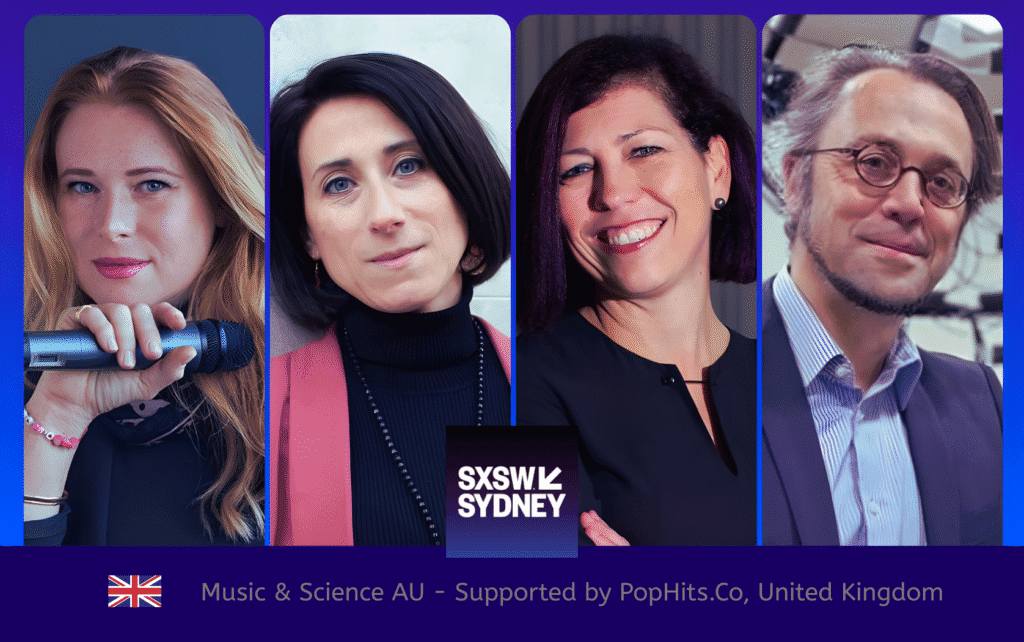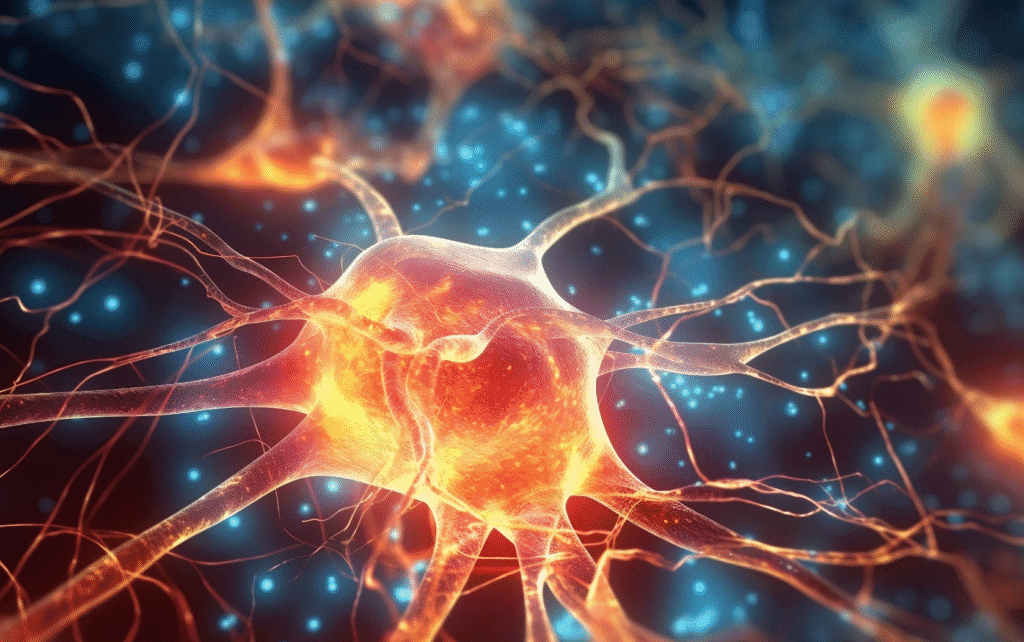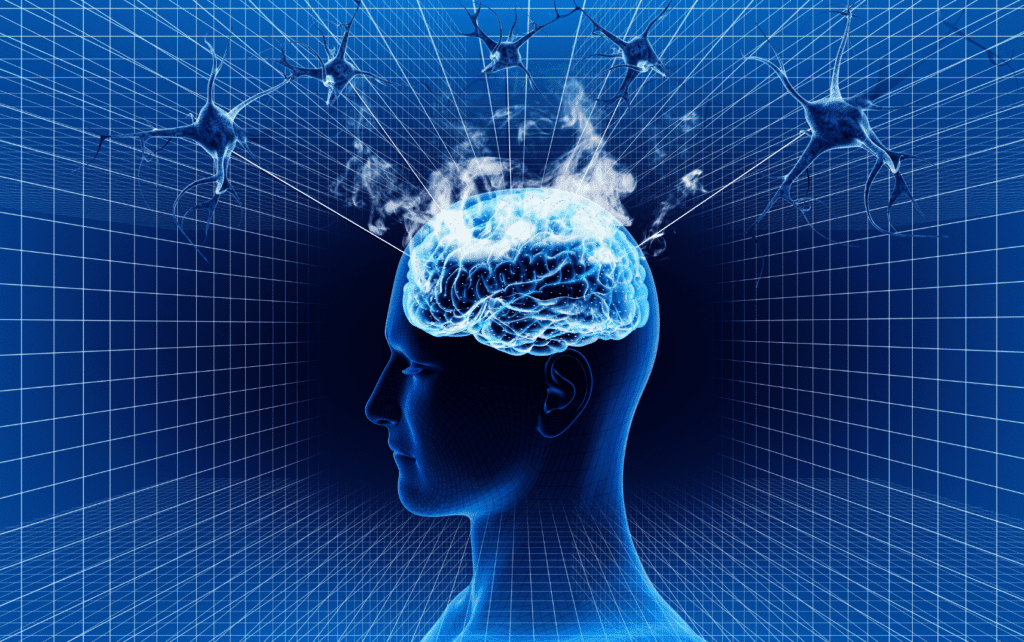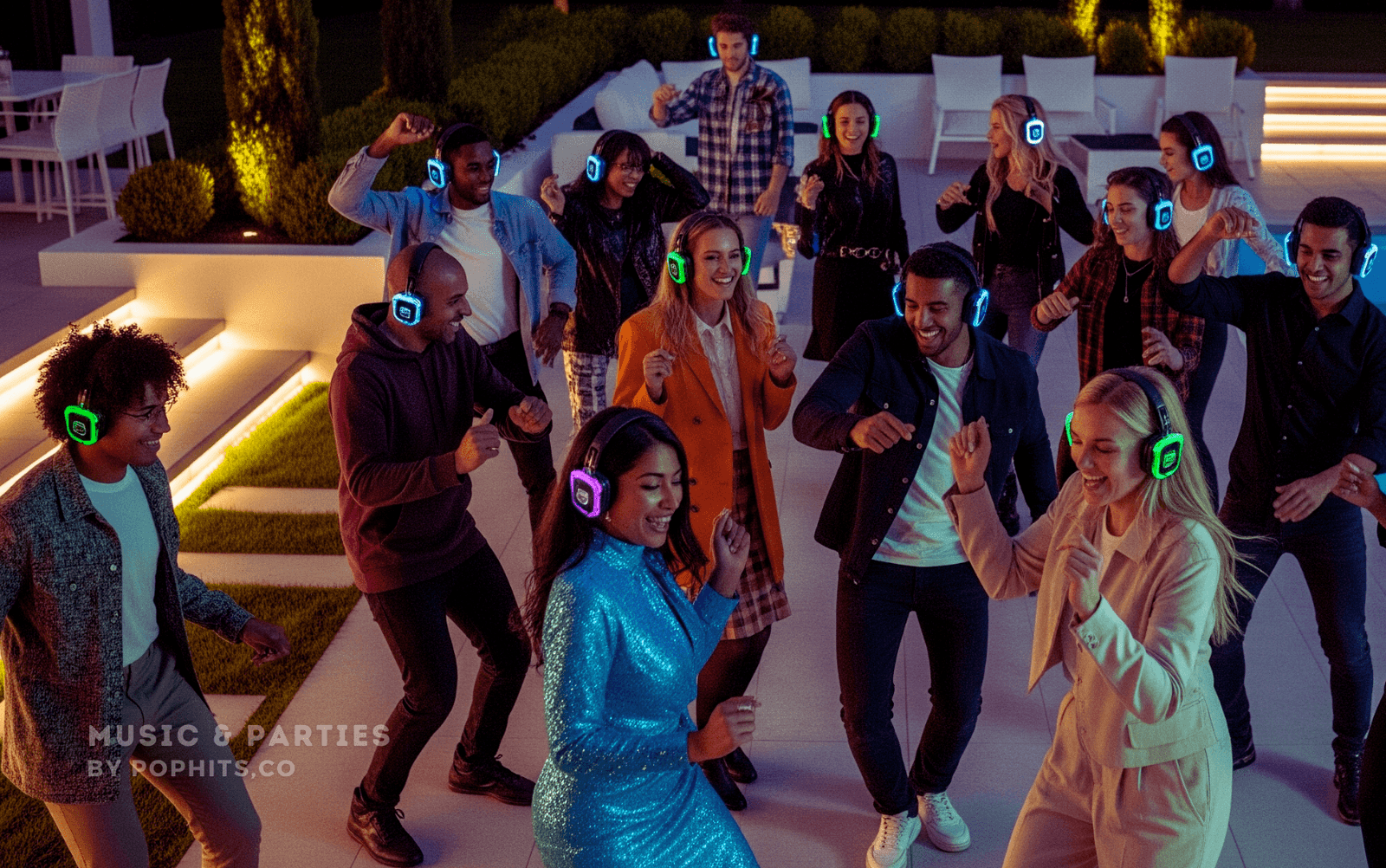
Prescribing Music: Innovation in Healthcare and Wellness at SXSW Sydney 2025, featuring Emmanuella Grace, Virginie Chelles, Felicity Baker, and Simone Dalla Bella.
In hospitals across the globe, a revolutionary shift is taking place. Music is no longer just background ambiance or entertainment—it’s being prescribed as medicine.
From operating rooms to psychiatric wards, rehabilitation centers to hospice care, sound is emerging as one of the most powerful therapeutic tools in modern healthcare. But this isn’t just about emotional comfort or psychological support. The science reveals something far more profound: music transforms us at the cellular level.
The Science Behind Sound: From Vibration to Cellular Transformation
Music is not merely an abstract artistic expression floating through the air. It is physics in motion—a series of mechanical waves that create vibration, and vibration is fundamentally electromagnetic. When we understand that our bodies are electromagnetic systems—our neurons firing electrical signals, our hearts generating electromagnetic fields detectable several feet away, our cells communicating through bioelectrical impulses—we begin to grasp why music has such profound physiological effects.

How Sound Waves Interact with Human Biology
- Brain Function: Research from Frontiers in Neuroscience demonstrates that musical training creates measurable changes in brain structure and connectivity. Neuroimaging studies reveal that music activates multiple brain regions simultaneously—more than almost any other stimulus. The auditory cortex, motor cortex, limbic system (emotion center), and prefrontal cortex (decision-making) all light up in coordinated patterns. This synchronized brain activity has been shown to enhance neuroplasticity, the brain’s ability to form new neural connections.
- Cardiovascular System: Studies show that specific musical tempos can synchronize with and positively influence heart rate variability. Research indicates that listening to music with tempos between 60-80 beats per minute can promote cardiovascular coherence, reducing stress-related strain on the heart. This rhythmic entrainment effect has been observed to improve autonomic nervous system balance, enhancing the parasympathetic response that supports relaxation and recovery. Furthermore, slow-tempo music has been associated with decreased blood pressure and improved arterial function, while moderate tempos may optimize heart rate patterns during physical rehabilitation and exercise recovery periods.
- Immune Function: Peer-reviewed research published in the Journal of Music Therapy documents that listening to music increases immunoglobulin A (an antibody crucial to immune function) and natural killer cell activity. The vibrational frequencies appear to stimulate the production of proteins and hormones that strengthen immune response.
- Cellular Regeneration: Perhaps most remarkably, certain frequencies have been shown to influence cellular behavior. Studies on stem cells exposed to sound vibrations show altered gene expression and enhanced differentiation. The mechanical vibrations can affect cell membrane permeability, potentially influencing how cells absorb nutrients and eliminate waste.

The Electromagnetic Connection: Why Frequency Matters
When we say music is electromagnetic, we’re acknowledging that sound waves—pressure waves traveling through air—create electrical signals when they’re converted by our auditory system. But the relationship goes deeper. Our nervous system operates on electrical principles, our muscles contract through electrical signals, and even our DNA has been found to conduct electricity in specific ways.
The Body’s Natural Frequencies
Every organ, tissue, and cell in our body has what’s called a “resonant frequency”—the natural frequency at which it vibrates. When external frequencies match or harmonize with these natural frequencies, resonance occurs, amplifying the effect. This is why certain frequencies feel physically affecting while others don’t register as strongly.
Research in cymatics (the study of visible sound vibration) shows that different frequencies create different geometric patterns in matter. Applied to human biology, this suggests that the frequencies we expose ourselves to can literally reorganize biological structures at microscopic levels.

Music as Medicine: Real Clinical Applications
The theoretical science is compelling, but what makes this truly revolutionary is how it’s being implemented in healthcare settings right now.
Prescribing Music at SXSW Sydney: A Groundbreaking Panel
A landmark event highlighting this transformation is taking place at SXSW Sydney, where clinicians, researchers, and music tech pioneers are convening to explore how music is being delivered as medicine in hospitals.
The panel, titled “Prescribing Music: Innovation in Healthcare and Wellness,” features experts including Simone Dalla Bella from the Laboratory for Brain, Music and Sound Research (BRAMS), Felicity Baker from MatchPlus, and Emmanuella Grace from Find Your Voice. These leaders are at the forefront of integrating music therapy into patient-personalized care, exploring AI’s role in healing through music, and addressing the critical infrastructure needs around licensing and scalability.
What makes this so significant?
This isn’t about casual music listening or recreational therapy. These experts are developing systematic, evidence-based protocols for prescribing specific musical interventions—with real-time biofeedback, outcome measurements, and patient-personalized catalogs. They’re creating the framework for music to be treated with the same rigor and standardization as pharmaceutical interventions.
Clinical Evidence Across Conditions
- Neurological Rehabilitation: Stroke patients using rhythmic auditory stimulation show significant improvements in gait, balance, and motor coordination. A study published in Philosophical Transactions of the Royal Society B explains the mechanisms behind how rhythmic auditory cues facilitate movement rehabilitation. The rhythmic cues help rebuild neural pathways damaged by stroke.
- Pain Management: According to research from the National Institutes of Health, music therapy provides measurable pain relief through multiple neurological pathways. Music therapy has been shown to reduce the need for opioid pain medications in post-surgical patients by up to 20%. The mechanism appears to involve both distraction and the release of endogenous opioids (the body’s natural painkillers).
- Mental Health: Depression and anxiety disorders respond to music therapy with measurable reductions in symptoms. Music can regulate neurotransmitter levels—particularly dopamine, serotonin, and oxytocin—creating biochemical shifts comparable to pharmaceutical interventions but without side effects.
- Alzheimer’s and Dementia: Perhaps the most moving applications involve dementia patients who’ve lost verbal communication but retain musical memory. Music activates preserved brain regions, allowing patients to reconnect with identity, memory, and emotion.
- Neonatal Care: Premature infants in NICUs exposed to gentle, rhythmic music show improved feeding behaviors, better sleep patterns, and even enhanced oxygen saturation levels. The sound appears to simulate the rhythmic environment of the womb, supporting physiological regulation.

The Physical Mechanisms: Breaking Down the Healing Process
Brain Entrainment and Neuroplasticity
Brain entrainment—the tendency for brainwave patterns to synchronize with external rhythmic stimuli—is one of music’s most powerful effects.
Different musical tempos can guide the brain into specific states:
- Delta waves (0.5-4 Hz): Deep sleep, healing, regeneration—induced by very slow, sustained tones
- Theta waves (4-8 Hz): Deep relaxation, meditation, creativity—encouraged by slow, flowing music
- Alpha waves (8-14 Hz): Relaxed alertness, stress reduction—promoted by calm, harmonious music
- Beta waves (14-30 Hz): Active thinking, focus, problem-solving—stimulated by upbeat, complex music
This isn’t metaphorical—EEG studies directly measure these brainwave changes in real-time during music exposure.
Beyond traditional music, emerging research explores binaural beats—slightly different frequencies played in each ear that create a perceived third tone—and specific Hz frequencies (like 432 Hz or 528 Hz) that may directly influence brainwave states, opening new possibilities for targeted therapeutic interventions.
Examples of Binaural Music that Affects the Brain Through Specific Frequencies:
Hormonal Regulation Through Sound
Music directly influences our endocrine system:
- Cortisol Reduction: Listening to relaxing music for just 30 minutes can reduce cortisol (stress hormone) levels by up to 25%. This has cascading effects on inflammation, immune function, and healing.
- Oxytocin Release: Group music-making (singing, drumming) stimulates oxytocin production, the “bonding hormone” associated with trust, empathy, and social connection. This may explain why music therapy is particularly effective in group settings.
- Dopamine Surge: Music that gives us chills or strong emotional responses triggers dopamine release in the brain’s reward centers—the same neurotransmitter involved in pleasure, motivation, and learning.
Muscle Memory and Physical Rehabilitation
The motor cortex (responsible for movement) and auditory cortex (processing sound) are intimately connected. Rhythmic music automatically activates motor planning regions, which is why we instinctively tap our feet or nod our heads. In rehabilitation contexts, this brain-body connection is leveraged to rebuild motor skills after injury.
Patients with Parkinson’s disease, for example, often experience “freezing” episodes where they cannot initiate movement. But when rhythmic music is played, their motor cortex receives the external timing cues it needs, allowing movement to resume. The music essentially bypasses the damaged neural circuits.
The Emotional and Psychological Dimension
While the physical mechanisms are remarkable, music’s power extends deeply into emotional healing. Trauma, grief, anxiety, and depression all leave physiological signatures—altered stress responses, inflammation, disrupted sleep, and hormonal imbalances. Music addresses both the emotional experience and its physical manifestations simultaneously.
Music as a Language Beyond Words
For patients who cannot verbalize their pain—whether due to trauma, developmental disability, or language barriers—music provides an alternative communication channel. Music therapists use improvisation, songwriting, and listening exercises to help patients express, process, and release emotions that have no words.
Creating Safety Through Sound
Polyvagal theory, which explains how our nervous system responds to safety and threat, reveals that prosodic vocal qualities (the melody and rhythm of voice) signal safety to our autonomic nervous system. Calming music mimics these safety signals, shifting the nervous system out of fight-or-flight mode and into a state conducive to healing.
The Future: Integration and Innovation
What’s particularly exciting about the developments showcased at events like the SXSW Sydney panel is the systematic integration of technology, personalization, and rigorous research. We’re moving beyond anecdotal evidence into an era of:
AI-Powered Personalization: Algorithms that analyze patient data—physiology, musical preferences, real-time biofeedback—to prescribe optimal musical interventions.
Streaming and Accessibility: Making therapeutic music accessible beyond clinical settings, allowing patients to continue treatment at home.
Licensing Solutions: Creating frameworks that respect artist rights while enabling widespread therapeutic use.
Outcome Measurement: Developing standardized metrics to demonstrate efficacy, essential for insurance coverage and mainstream medical acceptance.

Why This Matters Now
In an era of rising healthcare costs, overmedication, and increasing awareness of holistic approaches, music represents a non-invasive, cost-effective, side-effect-free intervention that addresses root causes rather than just symptoms. The fact that major institutions are now investing in music medicine programs signals a fundamental shift in how we understand healing.
The convergence of neuroscience, technology, and therapeutic practice means we’re no longer guessing.
We can measure, optimize, and prescribe music with precision. We can document outcomes and refine protocols. We can scale interventions that were once limited to specialized practitioners.
Conclusion: The Resonance of Healing
Music heals because we are, fundamentally, vibrational beings. Our hearts beat rhythms, our lungs cycle breath, our neurons fire in patterns, our cells oscillate with electrical potential. When we introduce organized, intentional vibration through music, we’re not adding something foreign to our biology—we’re harmonizing with it.
The science proves what humanity has intuited for millennia: music is medicine. But now, we’re learning to prescribe it with the sophistication and specificity it deserves. The work being done by pioneers in the field—like those presenting at SXSW Sydney—represents not just an advancement in healthcare, but a reclamation of something essential about human healing.
As we continue to unravel the mysteries of how sound transforms matter, how frequency influences function, and how rhythm reorganizes systems, we’re discovering that the most advanced medicine might also be the most ancient: the healing power of music, applied with scientific precision and compassionate intention.
The future of medicine is increasingly personalized, preventive, and patient-centered. Music fits all three criteria perfectly. And as technology makes therapeutic music more accessible and measurable, we’re standing at the threshold of a healthcare revolution—one that sounds beautiful.
Frequently Asked Questions About Music Healing at the Cellular Level
How does music actually heal the body at a cellular level?
Music creates mechanical vibrations that travel through your body’s tissues and fluids. Since the human body is approximately 60% water, these sound waves conduct efficiently throughout your system. At the cellular level, specific frequencies can influence cell membrane permeability, affect gene expression in stem cells, and stimulate the production of healing proteins and hormones. The vibrations literally cause physical changes in how cells function, communicate, and regenerate.
Can music therapy replace traditional medical treatment?
Music therapy should not replace traditional medical treatment but rather complement it as an integrative approach. Research shows music can reduce the need for pain medications by up to 20%, lower cortisol levels by 25%, and improve outcomes in stroke rehabilitation, mental health treatment, and post-surgical recovery. It works best when prescribed alongside conventional medicine, offering a non-invasive, side-effect-free enhancement to standard care protocols.
What is the SXSW Sydney “Prescribing Music” event about?
The “Prescribing Music: Innovation in Healthcare and Wellness” panel at SXSW Sydney features leading experts including Simone Dalla Bella from BRAMS, Felicity Baker from MatchPlus, and Emmanuella Grace from Find Your Voice. They’re exploring how music is being systematically delivered as medicine in hospitals, discussing AI’s role in personalizing therapeutic music, real-time biofeedback systems, and addressing licensing and scalability challenges to make music medicine mainstream.
Which medical conditions respond best to music therapy?
Music therapy shows particularly strong results for neurological conditions (stroke, Parkinson’s disease, dementia), mental health disorders (depression, anxiety, PTSD), pain management (post-surgical, chronic pain), neonatal care (premature infants), and cardiovascular health. Alzheimer’s patients often retain musical memory even after losing verbal communication, while stroke patients using rhythmic auditory stimulation show significant improvements in motor coordination and gait.
What are brainwave frequencies and how does music affect them?
Your brain operates on different electrical frequencies depending on your mental state. Music can “entrain” or synchronize these brainwaves: Delta waves (0.5-4 Hz) for deep sleep and healing, Theta waves (4-8 Hz) for relaxation and creativity, Alpha waves (8-14 Hz) for calm alertness, and Beta waves (14-30 Hz) for active thinking. By matching musical tempo and rhythm to desired brainwave states, music can guide your brain into specific healing or performance modes, measurable through EEG studies.
Is there scientific evidence that music affects the immune system?
Yes, multiple peer-reviewed studies document that listening to music increases immunoglobulin A (a crucial antibody for immune function) and enhances natural killer cell activity. Music listening also reduces cortisol (the stress hormone that suppresses immune function), triggers oxytocin release (which supports immune regulation), and decreases inflammatory markers. The vibrational frequencies appear to stimulate protein production that strengthens the body’s defense systems.
How is AI being used in music medicine?
AI is revolutionizing music therapy by analyzing patient data—including physiological responses, musical preferences, and real-time biofeedback—to prescribe optimal musical interventions. Machine learning algorithms can match specific frequencies, tempos, and compositions to individual patient needs, adjusting in real-time based on heart rate variability, brainwave patterns, and other biomarkers. This personalization makes music medicine as precise as pharmaceutical prescriptions.
Can I use music for self-healing at home?
Absolutely. While clinical music therapy with trained professionals offers the most targeted approach, you can incorporate therapeutic music into daily life. For stress reduction, listen to music around 60 beats per minute. For focus and productivity, choose music in the Beta wave range (upbeat, complex). For sleep, select slow, sustained tones that encourage Delta waves. Apps and streaming services are increasingly offering therapeutic playlists, though personalized professional guidance yields the best results for specific conditions.

Streaming Culture Sets the Stage for a New Era of Free Play

















